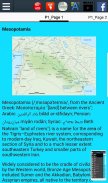








Ancient Mesopotamia History

توضیحات Ancient Mesopotamia History
Mesopotamia (/ˌmɛsəpəˈteɪmiə/, Ancient Greek: Μεσοποταμία "[land] between rivers"; from Ancient Armenian Միջագետք (Mijagetq); Arabic: بلاد الرافدين bilād ar-rāfidayn; Kurdish: میزۆپۆتامیا; Persian: میانرودان miyān rodān; Syriac: ܒܝܬ ܢܗܪܝܢ Beth Nahrain "land of rivers") is a name for the area of the Tigris–Euphrates river system, in modern days roughly corresponding to most of Iraq plus Kuwait, the eastern parts of Syria, Southeastern Turkey, and regions along the Turkish-Syrian and Iran–Iraq borders.
Widely considered to be one of the cradles of civilization by the Western world, Bronze Age, Mesopotamia included Sumer and the Akkadian, Babylonian, and Assyrian empires, all native to the territory of modern-day Iraq. In the Iron Age, it was controlled by the Neo-Assyrian and Neo-Babylonian Empires.
The Sumerians and Akkadians (including Assyrians and Babylonians) dominated Mesopotamia from the beginning of written history (c. 3100 BC) to the fall of Babylon in 539 BC, when it was conquered by the Achaemenid Empire. It fell to Alexander the Great in 332 BC, and after his death, it became part of the Greek Seleucid Empire.
Around 150 BC, Mesopotamia was under the control of the Parthian Empire. Mesopotamia became a battleground between the Romans and Parthians, with western parts of Mesopotamia coming under ephemeral Roman control. In AD 226, eastern part of it fell to the Sassanid Persians. Division of Mesopotamia between Roman (Byzantine from AD 395) and Sassanid Empires lasted until the 7th century Muslim conquest of Persia of the Sasanian Empire and Muslim conquest of the Levant from Byzantines. A number of primarily neo-Assyrian and Christian native Mesopotamian states existed between the 1st century BC and 3rd century AD, including Adiabene, Osroene, and Hatra.
Mesopotamia is the site of the earliest developments of the Neolithic Revolution from around 10,000 BC.[citation needed] It has been identified as having "inspired some of the most important developments in human history including the invention of the wheel, the planting of the first cereal crops and the development of cursive script, mathematics, astronomy and agriculture."
بین النهرین (/ ˌmɛsəpəteɪmiə /، یونانی باستانی: Μεσοποταμία "[زمین] بین رودخانه ها"؛ از ارمنستان باستان Միջագետք (Mijagetq) عربی: بلاد الرافدين البلاد AR-رافضیه؛ کردی میزۆپۆتامیا؛ فارسی: میانرودان miyān RODAN؛ سریانی: ܒܝܬ ܢܗܪܝܢ بث نهرین "سرزمین رودخانه ها") یک نام برای این منطقه از رودخانه دجله و فرات است، در روز مدرن تقریبا مربوط به بسیاری از عراق به علاوه کویت، شرق سوریه، جنوب شرقی ترکیه، و مناطق در امتداد مرزهای ترکیه و سوریه و ایران و عراق.
به طور گسترده ای به عنوان یکی از گهواره های تمدن های جهان غرب، عصر برنز، بین النهرین شامل سومر و اکدی، بابلی، و امپراتوری آشوری، همه مادری به قلمرو عراق امروزی. در عصر آهن، آن را توسط امپراتوری نئو آشوری و بابلی کنترل می شد.
سومریان و آکادیان (از جمله آشوریان و بابلیان) بین النهرین از آغاز تاریخ نوشته شده است (ج. 3100 سال قبل از میلاد) به سقوط بابل در 539 قبل از میلاد تحت سلطه، وقتی که توسط امپراتوری هخامنشی فتح شد. آن را به اسکندر کبیر کاهش یافت و در 332 قبل از میلاد، و پس از مرگ او، آن را بخشی از یونانی سلوکیان شد.
حدود 150 سال قبل از میلاد، بین النهرین تحت کنترل امپراتوری اشکانی بود. با بخش های غربی بین النهرین تحت کنترل روم زودگذر، بین النهرین یک میدان نبرد میان رومیان و پارتیان شد. در 226 میلادی، بخش شرقی آن را به ایرانیان ساسانی سقوط کرد. بخش بین النهرین بین روم (بیزانس از 395 م) و ساسانیان امپراتوری تا 7 فتوحات مسلمانان قرن ایران امپراتوری ساسانی و فتوحات مسلمانان در شام از بیزانس به طول انجامید. تعدادی از کشورهای بین النهرین بومی در درجه اول نئو آشوری و مسیحی بین 1 سال قبل از میلاد قرن و قرن 3 میلادی، از جمله آدیابن، اسروئن و حضر وجود داشته است.
بین النهرین سایت از اولین تحولات انقلاب نوسنگی از سراسر 10،000 BC است. [نیازمند منبع] از آن شده است به عنوان داشتن "برخی از تحولات مهم در تاریخ بشر از جمله اختراع چرخ، کاشت اولین الهام گرفته شده غلات و توسعه خط خط شکسته، ریاضیات، نجوم و کشاورزی است. "


























